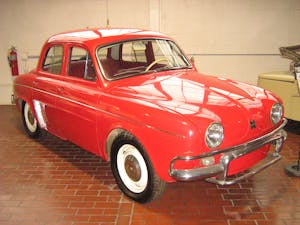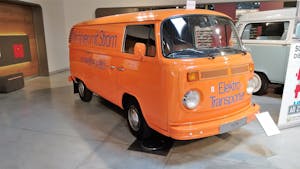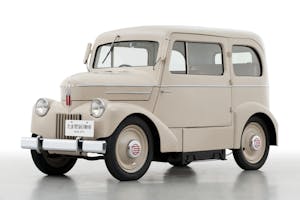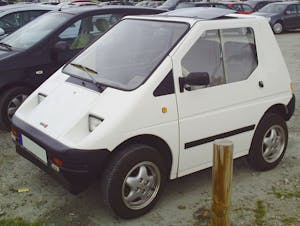5 obscure electric cars you’ve (probably) never heard of
The humble electric car has for many decades flirted with mainstream success, leaving behind a trail of breadcrumbs that leads us to today’s Teslas and Taycans. Many remember the General Motors EV1 and, to a lesser extent, the Toyota Rav4 and Honda Fit EVs, but these days electric cars closer to widespread acceptance than ever before. Companies are investing untold billions into the development of electrified vehicle platforms, and before long our beloved hydrocarbon-huffing internal combustion engines could seem old hat. Until then, it’s worth looking back at some of history’s showroom-sold EVs that ran out of juice. Some of these were mad sciences projects, while others were destined from the get-go as consumer projects, but all deserve recognition for their forward-thinking innovation.
Henney Kilowatt

Despite being wrapped up in a croissant, the American-built Henney Kilowatt was a unique slice of 1959 industrial powerhouses, including Eureka Vacuums and Exide Batteries, all working together under the umbrella of the National Union Electric Company to churn out an electric-powered sedan for the masses for 1959 and 1960. National Union Electric Co. had a vested interest in the success of EVs with their stake in battery manufacturers like Exide, which produced lead-acid batteries. 100 engineless Renault Dauphines were ordered from the factory by Henney Coachworks, which had begun building horse buggies nearly 100 years prior before moving on to hearse and limo conversions, and eventually their brief diversion into EVs.
Passing the Henney in any other car was of little challenge; its initial top-speed was around 40 mph. The powertrain, which was built at Eureka Vacuums’ Bloomington, Illinois factory, had its controller designed with the assistance of Caltech engineers. Twelve six-volt batteries gave Kilowatt up to 40 miles of range, which was paltry even for 1959. The following year, Henney added two more batteries for a total of 14, raising the system voltage from 48 to 72 volts. This wound the top speed up to 60 mph and a total range of a 60 miles, but the series of batteries increased the Kilowatt’s curb weight nearly 1000 pounds over a standard Dauphine. Out of the 100 bodies ordered by Henney, 47 were completed and sold to public and fleet customers—notably, power companies.
However, the Dauphine’s corpse wasn’t done being electrified by curious engineers.In 1971 Bell Laboratories would buy a Dauphine to build into its own EV development car over the next few years, introducing a rudimentary regenerative braking system. While it had no direct relation to the Kilowatt, the spirit was surely there.
1972 T2 Elektro Transporter

This safety flare on wheels is Volkswagen’s first EV, long before the e-Golf and ID.3. The 22-horse 1972 Elektro Transporter was based on the standard Type 2 transporter, fitted with custom reinforcements for the 1873-pound battery pack. That was more than a whole Beetle, but the hardy Transporter still maintained a payload capacity of nearly a ton. Range was up to approximately 50 miles, but the Elektro Transporter had a novel solution to its short range and long charging times: local charging stations could swap the pack out through the side of the Transporter, getting back on the road with roughly the same effort as swapping batteries in your TV remote.
According to VW, 120 units were pumped out of the Hannover commercial vehicles factory in a multitude of body styles, including the flat-bed truck body. The Elektro’s ideal customer was an urban delivery business or farmer, who needed a no-stress van for hauling products locally.
1947 Tama Electric Car

This adorable wagon is the result of Japan’s return to relative normalcy after World War II, following the establishment of the Tokyo Electro Automobile Company. Built with the braintrust of Tachikawa Aircraft Company after Allied powers dismantled Japan’s aircraft industry, the Tama was an answer to the gasoline shortages created after WWII. Allied forces had also destroyed much of Japan’s manufacturing capabilities, so the Tama was almost entirely hand-built, with the bodywork being constructed of a wood frame surrounded by hammer-shaped steel panels. Without access to the presses and toolmaking machines, Tama’s aircraft-bred craftsmen were still able to incorporate streamlined details such as the integrated headlight buckets in the front fenders (compared the “pod” mounted headlamps that were still common during this time).
A pioneer in many ways, the Tama also had two replaceable battery units, which were accessed through the panel below the front doors. They even featured built-in roller wheels so that maneuvering the battery trays was more convenient. A 4.5-hp DC motor was powered by the 40V pack, and the drivetrain gave the 2400-pound Tama a 22-mph top speed for up to 60 miles. It was produced as both a two-door, four-seat wagon along with a two-seat pick-up, and it even became a fairly practical taxi until the early ’50s.
The Tokyo Electro Automobile Company would eventually morph into Prince Motors before being absorbed by Nissan/Datsun in 1966. So, depending on your interpretation of history, that means the humble Tama could stands as Nissan’s first EV, much to the chagrin of Leaf disciples everywhere.
Vanguard CitiCar

Eagled-eyed readers might identify the genealogy of one of history’s more notorious EVs, the Vanguard CitiCar. Taking after the cheese-wedge styling of the CitiCar, Knud Erik began manufacturing the Knud Erik Westergaard Elektrisk Transport (Kewet) in 1991. The four-wheeled door stop was introduced with a simple 48-volt motor and four-speed manual, but would eventually jump to 72 volts and utilize a single-speed transmission. The latter is a common trait between every EV we’ve listed, thanks to the judicious torque that an electric motor makes available at even the Kewet’s modest power levels. Output for the Kewet began at approximately 6 hp before seeing an upgrade to 16 hp with the higher-voltage upgrades that arrived later in its production. The microscopic footprint of the Kewet gave it the same party trick as the adorable Smart ForTwo—it could be street-parked perpendicular to the roadway to save space, as its overall length was less than the width of a standard car.
While it never saw the ultimate success of 1974 to 1977 CitiCar it emulated (which moved 4444 units, the most successful EV ever sold until Tesla’s Model S), the Kewet experienced modest success with 1500 of its tiny three-seaters sold, including the renamed “Buddy” models that came later. This is probably the first retro-styled EV ever produced, when you think about it—little different than our recent lust for SSRs, T-Birds, and Prowlers, the Kewet’s styling sought to shake up memories of the past with most of its features being based on its ’70s role-model. Today, projects like the Honda E are applying the same tricks, shaping up ghosts of the pasts for modern service atop the most advanced bones available.
1898 Egger-Lohner C.2 Phaeton

At 22, Ferdinand Porsche began work on what would become his first vehicle, a humble electric carriage released under the Egger-Lohner company in the form of a two-row, open roof transporter. Today, Porsche’s Taycan is seen as a fresh take on the luxury sedan, but the 1898 Egger-Lohner C.2 Phaeton, also known as the Porsche P1, was entering the fray during a time when gasoline vehicles weren’t yet the default motive power for horseless carriages. Mr. Porsche had began working at the Bela Egger & Co electric company at the age of 18, and he had become the head of the company’s testing department by 1897, when he began developing the motorized powertain used by the Egger-Lohner C.2 and its hub-motored successor, the series-hybrid 1900 Lohner-Porsche Electromobile. To support the 1100-pound battery pack, Egger & Co. worked with a coachbuilder, Jacob Lohner & Co., to develop the wooden chassis.
The two axle-mounted motors produced an orbit-shifting 5 hp, but the 50-mile range was respectable even when compared to gasoline engines from the time period. Its 20-mph Vmax, when combined with its consistent performance compared to the cantankerous hydrocarbon burners in the 19th century, was enough to take first place in the 24-mile 1899 Berlin road race with an 18-minute gap on the second-place finisher, which helped stake out the promising automotive future EV vehicles have always endeavored to fulfill.

